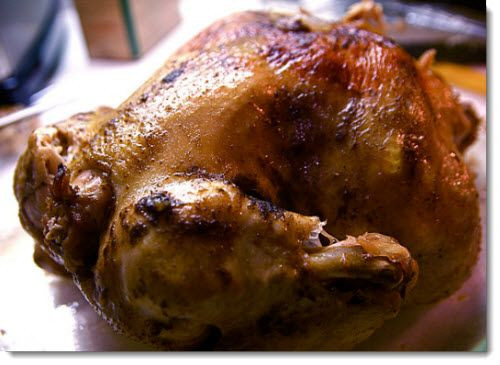6 Tips To Prevent Salmonella: How To Purchase, Wash, And Cook Your Chicken Safely

Now that the USDA has allowed Foster Farms, the source of the Salmonella heidelberg outbreak, to remain open, the responsibility of preventing foodborne diseases is largely in the hands of consumers preparing food and cooking meat at home.
Salmonella can be found in foods other than poultry, including protein bars and spinach. But public attention is drawn to the dangers of chicken, since up to 300 people in recent months have been sickened from poultry traced back to California facilities owned by Foster Farms. Although Salmonella outbreaks, in theory, should be prevented at the processing plant level and that of federal regulation, it’s important for people cooking at home to take precautions into their own hands. Severe cases of salmonellosis require hospitalizations and are increasingly resistant to antibiotics.
Don’t Wash The Chicken
Ben Chapman, food safety specialist at North Caroline State University, told LiveScience that washing raw chicken can actually promote cross-contamination, or spreading the germs from chicken onto other foods and your kitchen surfaces.
“If you could see germs, you would see that washing poultry just splashes bacteria all over you, the kitchen, and other foods,” according to Drexel University’s “Don’t Wash Your Chicken” public health initiative. Cooking the chicken thoroughly without washing it will kill the bacteria without needlessly spreading it onto other surfaces.
Prevent Cross Contamination
Cross contamination can happen at any point, from the moment you touch the packaged raw chicken at the grocery store to the time you're preparing it in your kitchen. The most important detail to look for is any juice leaking out of the package. Be sure to place the chicken package into an individual plastic bag to keep it self-contained.
Paying attention to washing your hands and separating meat utensils from those you use for chopping vegetable are also important practices. Raw meat and its juices can spread bacteria across knives, your hands, your apron, and the kitchen counter.
Know the Difference Between Frozen and Fresh
When buying fresh chicken meat, it should feel soft and cold, but not frozen. Fresh meat refers to raw poultry that has never been held in temperatures lower than 26 degrees Fahrenheit, according to the United States Department of Agriculture (USDA). With fresh meat, make sure to place it in the refrigerator immediately after buying it for no more than 1-2 days before cooking. If you don’t plan on using the chicken after the second day, freeze it.
Chicken and other raw meats that are frozen can last indefinitely in the freezer. Once cooked, you can place the meat in the fridge for up to 4 days.
Foodborne bacteria is more likely to multiply at a temperatures between 40 and 140 degrees Fahrenheit, the USDA states on its website. So the longer you keep your meat at extreme temperatures — frozen, refrigerated or on the pan — the safer your meat will be.
Thaw Properly
Thawing frozen meat can be done in the fridg, or by placing the chicken in a bowl of cold water. The Food Safety and Inspection Service (FSIS) also recommends microwaving as an option. Chapman told LiveScience that when thawing a chicken, be sure that the outside of the meat isn’t above 41 degrees Fahrenheit for more than four hours.
Cook Thoroughly
Perhaps the most important part of preparing chicken is cooking it thoroughly to ensure any traces of bacteria are fully killed. The only way to properly check whether a chicken is cooked properly is by inserting a thermometer into the meat to read its internal temperature, whether you’re frying, baking, or grilling the chicken. The chicken's interior should be at 165 degrees Fahrenheit, and the temperature should be measured at several spots inside the chicken to ensure consistency. The USDA offers a chart detailing the approximate proper cooking times for various chicken parts.
Reheat Leftoves To The Proper Temperature
Even if the chicken was cooked fully to 165 degrees Fahrenheit initially, it’s important to make sure chicken leftovers are reheated to the same temperature the next day. Heating in the microwave may leave some spots of the chicken colder than others, so be sure to double check with a termometer.
For more information about the current Salmonella outbreak, read the USDA’s current public health alerts here.



























